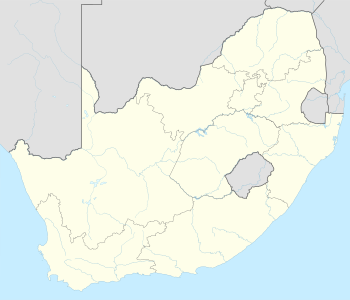قائمة مواقع التراث العالمي في جنوب أفريقيا
The United Nations Educational, Scientific and Cultural Organization (UNESCO) World Heritage Sites are places of importance to cultural or natural heritage as described in the UNESCO World Heritage Convention, established in 1972.[1] Cultural heritage consists of monuments (such as architectural works, monumental sculptures, or inscriptions), groups of buildings, and sites (including archaeological sites). Natural features (consisting of physical and biological formations), geological and physiographical formations (including habitats of threatened species of animals and plants), and natural sites which are important from the point of view of science, conservation, or natural beauty, are defined as natural heritage.[2] South Africa accepted the convention on 10 July 1997.[3] There are ten World Heritage Sites in South Africa, with a further two on the tentative list.[3]
The first three sites in South Africa were added to the list in 1999 while the most recent one, the Barberton Makhonjwa Mountains, was added in 2018. Five sites are listed for their cultural significance, four for natural, and one site, the Maloti-Drakensberg Park, is listed for both. This site is transnational as it is shared with Lesotho.[3] South Africa has served as a member of the World Heritage Committee three times: 1999–2005, 2009–2013, and 2019–2023.[3]
مواقع التراث العالمي
UNESCO lists sites under ten criteria; each entry must meet at least one of the criteria. Criteria i through vi are cultural, and vii through x are natural.[4]
| Site | Image | Location (province) | Year listed | UNESCO data | Description |
|---|---|---|---|---|---|
| Fossil Hominid Sites of South Africa | 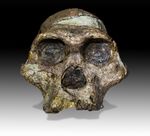
|
North West, Limpopo, Gauteng | 1999 | 915bis; iii, vi (cultural) | This site comprises caves and other locations where the remains of Australopithecus africanus, dating up to 3.5 million years ago, and Paranthropus, dating up to 4.5 million years ago, were discovered, providing crucial insight into human evolution. The sites at Sterkfontein (A. africanus skull, known as Mrs. Ples, pictured), Swartkrans, and Kromdraai, collectively named the Cradle of Humankind, were listed in 1999. Makapan Valley and Taung, where the Taung Child was found, were added in 2005.[5] |
| جزيرة روبن | 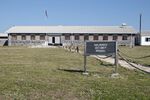
|
Western Cape | 1999 | 916; iii, iv (cultural) | Robben Island, a small island off the coast from Cape Town, was in different periods between the 17th and 20th centuries used as a hospital, prison, and a military base. It was used as a leper colony in the 19th century and as a maximum security prison for political prisoners during the Apartheid era, especially after the 1960s. Nelson Mandela, the anti-Apartheid activist, who later became the president of the country, was imprisoned here for 18 years. Today, the island symbolizes the victory of human spirit and democracy over oppression and racism.[6] |
| إيسيمانگاليسو، منتزه الأراضي الرطبة | 
|
كوازولو-ناتال | 1999 | 914; vii, ix, x (natural) | The park, located at the meeting point between tropical and subtropical Africa, features a mosaic of different types of habitats, including wetlands, sandy dunes, beaches, lakes (Lake St. Lucia pictured), and coral reefs. The area is rich in biodiversity, with large colonies of breeding water birds, sea turtles nesting on the beaches, and whales and dolphins inhabiting the sea.[7] |
| Maloti-Drakensberg Park* | 
|
كوازولو-ناتال | 2000 | 985; i, iii, vii, x (مختلط) | The site comprises the uKhahlamba-Drakensberg Park (pictured), originally listed independently in 2000, and the Sehlabathebe National Park in Lesotho, that was added in 2013. The area is known for its scenic beauty with basalt rock formations, river gorges, and grasslands. It is rich in biodiversity, in particular in numerous plant and bird species. The San people, who lived in the area for more than four millennia, created rock art depicting humans and animals. There are around 690 sites with rock art in the park.[8] |
| Mapungubwe Cultural Landscape | 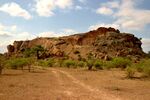
|
ليمپوپو | 2003 | 1099bis; ii, iii, iv, v (ثقافي) | The Kingdom of Mapungubwe was the first large kingdom in southern Africa, existing roughly between 900 and 1300. It was located in an open savanna at the confluence of the Limpopo and Shashe rivers. They traded with India and China and produced gold and ivory. The kingdom collapsed because of the climate change, as droughts rendered the area unsuitable for agriculture. Remains of palaces and settlements have been preserved. A minor boundary modification took place in 2014.[9] |
| Cape Floral Region Protected Areas | 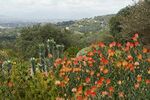
|
Western Cape, Eastern Cape | 2004 | 1007bis; ix, x (natural) | The site comprises a series of national parks and protected areas that are home to the plants of one of the six floral kingdoms of the world. The area is remarkably rich in biodiversity: although it covers less than 0.5% of Africa, it is home to 20% of plant species of the continent. The fynbos vegetation of fine-leaved shrubland is adapted to the Mediterranean climate of the region and to occasional fires. Many plants rely on pollination and seed dispersal by insects, birds, and mammals. Several plant species are of conservation concern. A significant modification to the site boundaries took place in 2015.[10] |
| Vredefort Dome | 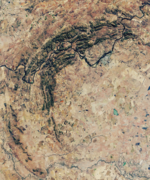
|
North West, Free State | 2005 | 1162; viii (natural) | The Vredefort Dome (satellite image pictured) is the impact structure, or astrobleme, created by a meteorite that hit the Earth around 2 billion years ago, releasing massive amounts of energy and causing devastating global effects. It is the oldest and, with a radius of 190 km (120 mi), the largest impact crater so far discovered on Earth. Although the structure has been deeply eroded, it is important in geological studies of meteorite impact sites. Geological strata covering 3.2 billion years are exposed.[11] |
| Richtersveld Cultural and Botanical Landscape | 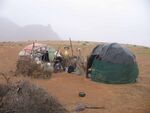
|
Northern Cape | 2007 | 1265; iv, v (cultural) | The cultural landscape of Richtersveld has been shaped over the period of at least two millennia by the semi-nomadic Nama people who still maintain a lifestyle that was in the past much more widespread in southern Africa. The Nama practice transhumance pastoralism, with moving their herds seasonally. They live in portable demountable mat-roofed houses, haru om (examples pictured). They have extensive knowledge of the medicinal plants that they collect.[12] |
| ǂKhomani Cultural Landscape | 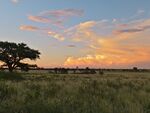
|
Northern Cape | 2017 | 1545; v, vi (cultural) | The cultural landscape of the Kgalagadi Transfrontier Park has been inhabited since the Stone Age by hunter-gatherer groups and is today associated with the formerly nomadic ǂKhomani people and related San groups. They have developed a lifestyle that allows them to cope in the harsh environment of the Kalahari Desert. They have developed specific ethnobotanical knowledge and today they are actively protecting their cultural traditions.[13] |
| Barberton Makhonjwa Mountains | 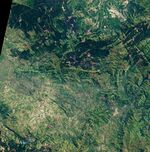
|
Mpumalanga | 2018 | 1575; viii (natural) | The mountains (satellite image pictured) contain some of the oldest geological structures on Earth. A sequence of volcanic and sedimentary rocks, beginning 3.6 billion years ago and spanning 340 million years, provide insight into the time when the first primitive unicellular life developed on Earth. The rocks document lava flows, meteorite bombardment, anoxic oceans, and the early atmosphere of the planet.[14] |
Tentative list
In addition to sites inscribed on the World Heritage List, member states can maintain a list of tentative sites that they may consider for nomination. Nominations for the World Heritage List are only accepted if the site was previously listed on the tentative list.[15] South Africa maintains two properties on its tentative list.[3]
| Site | Image | Location (province) | Year listed | UNESCO criteria | Description |
|---|---|---|---|---|---|
| The Emergence of Modern Humans: The Pleistocene occupation sites of South Africa | 
|
Eastern Cape, KwaZulu-Natal, Western Cape | 2015 | ii, iii, iv, v, vi (cultural) | Based on genetic and fossil evidence, anatomically modern humans developed from archaic predecessors in Africa around 200,000 years ago. This nomination comprises caves and rock shelters at different points occupied by Stone Age societies. The findings, including remains of small hearths, tools, and early art, provide insight into the life of these people. The sites are: Blombos (pictured), Border Cave, Diepkloof Rock Shelter, Klasies River Caves, Pinnacle Point, and Sibudu Cave.[16] |
| Human Rights, Liberation Struggle and Reconciliation: Nelson Mandela Legacy Sites | 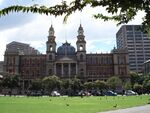
|
Gauteng, Eastern Cape, KwaZulu-Natal, Western Cape | 2015 | ii, iii, iv, vi (cultural) | This nomination comprises 13 sites associated with the human rights activists against the Apartheid regime of South Africa in a process that eventually led to the establishment of a multi-racial democracy in 1994. Among the most notable activists were Albert Luthuli, Desmond Tutu, and Nelson Mandela, all of which were the recipients of the Nobel Peace Prizes. The picture depicts the Palace of Justice in Pretoria, the site of the Rivonia Trial, where Mandela delivered the I Am Prepared to Die speech in 1964.[17] |
See also
المراجع
- ^ "The World Heritage Convention". UNESCO World Heritage Centre. Archived from the original on 27 August 2016. Retrieved 7 July 2019.
- ^ "Convention Concerning the Protection of the World Cultural and Natural Heritage". UNESCO World Heritage Centre. Archived from the original on 1 February 2021. Retrieved 3 February 2021.
- ^ أ ب ت ث ج "South Africa". UNESCO World Heritage Centre. Archived from the original on 24 January 2021. Retrieved 14 September 2022.
- ^ "UNESCO World Heritage Centre The Criteria for Selection". UNESCO World Heritage Centre. Archived from the original on 12 June 2016. Retrieved 17 August 2018.
- ^ "Fossil Hominid Sites of South Africa". UNESCO World Heritage Centre. Archived from the original on 1 September 2022. Retrieved 19 November 2023.
- ^ "Robben Island". UNESCO World Heritage Centre. Archived from the original on 4 January 2018. Retrieved 2 June 2011.
- ^ "iSimangaliso Wetland Park". UNESCO World Heritage Centre. Archived from the original on 2 August 2022. Retrieved 2 June 2011.
- ^ "Maloti-Drakensberg Park". UNESCO World Heritage Centre. Archived from the original on 3 September 2022. Retrieved 19 March 2023.
- ^ "Mapungubwe Cultural Landscape". UNESCO World Heritage Centre. Archived from the original on 21 December 2019. Retrieved 2 June 2011.
- ^ "Cape Floral Region Protected Areas". UNESCO World Heritage Centre. Archived from the original on 6 October 2019. Retrieved 2 June 2011.
- ^ "Vredefort Dome". UNESCO World Heritage Centre. Archived from the original on 1 August 2022. Retrieved 2 June 2011.
- ^ "Richtersveld Cultural and Botanical Landscape". UNESCO World Heritage Centre. Archived from the original on 22 March 2019. Retrieved 2 June 2011.
- ^ "ǂKhomani Cultural Landscape". UNESCO World Heritage Centre. Archived from the original on 11 July 2018. Retrieved 2 June 2023.
- ^ "Barberton Makhonjwa Mountains". UNESCO World Heritage Centre. Archived from the original on 2 July 2018. Retrieved 23 July 2018.
- ^ "Tentative Lists". UNESCO World Heritage Centre. Archived from the original on 24 September 2005. Retrieved 7 October 2010.
- ^ "The Emergence of Modern Humans: The Pleistocene occupation sites of South Africa". UNESCO World Heritage Centre. Archived from the original on 23 October 2022. Retrieved 22 August 2023.
- ^ "Human Rights, Liberation Struggle and Reconciliation: Nelson Mandela Legacy Sites". UNESCO World Heritage Centre. Archived from the original on 26 December 2022. Retrieved 22 August 2023.
